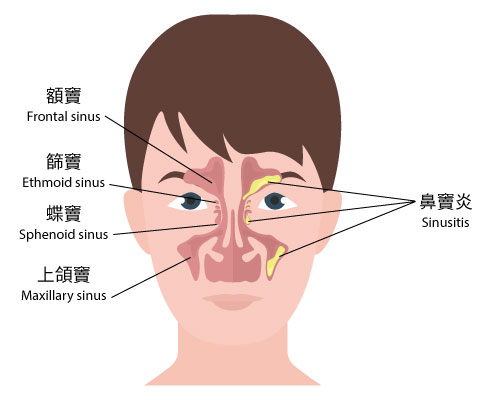Do You Have a Seasonal Cold, Allergic Rhinitis or Sinusitis?

Sinusitis is not familiar to most Hong Kong people, and is often confused with the common cold and allergic rhinitis. Although there are no exact numbers on how many patients suffer from sinusitis, it is still a common disease which affects 1 out of every 7 adults in the United States.
Anatomy
A sinus is simply a hollow space. There are four pairs of sinuses, named for the bones that they're located in: The frontal sinuses are located above the eyes, near the forehead. The maxillary sinuses are located on each side of the nose, near the cheek bones. The ethmoid sinuses are located on each side of the bridge of the nose, near your eyes. The sphenoidal sinus is in the sphenoid bone at the centre of the skull base under the pituitary gland.

What causes sinus problems?
Causes of sinus inflammation include viruses, bacteria, and fungi. If the tissue in the nose is swollen from allergies, a cold, or something in the environment, it can block the sinus passages. The sinuses cannot drain, and then leads to sinusitis.
How to tell the difference between cold and sinusitis?
Although there are some similar symptoms, such as a runny nose, in an uncomplicated cold, the sinusitis and the allergic rhinitis, they are actually different diseases. Acute sinusitis is inflammation that lasts up to four weeks. If the sinusitis falls between acute and chronic, meaning it lasts longer than four to twelve weeks. Chronic sinusitis lasts at least twelve weeks.
Symptoms
As you have several different sinuses above and below eyes as well as behind the nose, any of these can hurt when you have a sinus infection. Sometimes you will have pressure and achy sensation in face. This may lead to a fever, swelling and tenderness around the cheeks, as well as fatigue and malaise. Patients can have green-yellow nasal discharge during this period. As the discharge from the sinuses drains down the back of the throat, it can cause irritation.
Allergic rhinitis vs. sinusitis
Allergic rhinitis is inflammation of the inside of the nose caused by an allergen, such as pollen and dust. Patients may have some cold-like symptoms such a blocked or runny nose, sneezing and post-nasal drip. Although some of the symptoms seem similar between the two diseases, we can still distinguish between each one by the colour and the smelling of nasal discharge.

Diagnosis and treatment of sinusitis
If you have any of the above symptoms, and over-the-counter treatments don't help, you should see the ENT specialist at the earliest. The specialist will refer you for several testing if this is suspected, which includes nasal endoscopy, sinus X-rays, and CT scans. For most cases of sinusitis, the specialist may recommend treatments to help relieve sinusitis symptoms, including antibiotics, pain relievers, medicine for allergies, nasal spray, and saline nasal wash.
*The above information is for reference only, please consult your doctor for detail.

 3405 8288
3405 8288
